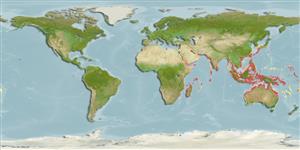Issue
Junior synonym Halichoeres kneril is a valid species according to Allen et al.,2012 (Ref. 90102). Species page will be created.
Environment: milieu / climate zone / depth range / distribution range
Ecología
marino asociado a arrecife; rango de profundidad 3 - 10 m (Ref. 90102). Tropical
Indo-West Pacific: East Africa and Persian Gulf to East Indian region (excluding Papua New Guinea and Solomon Islands); north to China and Taiwan; south to Australia.
Length at first maturity / Tamaño / Peso / Age
Maturity: Lm ?, range 7 - ? cm
Max length : 14.6 cm TL macho / no sexado; (Ref. 124478)
Short description
Claves de identificación | Morfología | Morfometría
Espinas dorsales (total) : 9; Radios blandos dorsales (total) : 12; Espinas anales: 3; Radios blandos anales: 11 - 12. This species is distinguished by the following characters: greatest body depth 2.9-3.6 in SL; pectoral-fin rays usually 14. Colour of male green on head and upper two-thirds of body, white on ventral part with inter-connected brown bars on side; lavander bands on head; between 6th and 7th dorsal spines, a diffuse dark spot; upper pectoral fin base with a small black spot; colour of female dark greenish-brown on upper half of body with several small, white spots along middle of the side (Ref. 90102).
Inhabit shallow weedy areas of rocky shorelines with little coral growth (Ref. 9710). Found in groups (Ref. 90102).
Life cycle and mating behavior
Maturities | Reproducción | Spawnings | Egg(s) | Fecundities | Larva
Distinct pairing during breeding (Ref. 205).
Parenti, P. and J.E. Randall, 2000. An annotated checklist of the species of the labroid fish families Labridae and Scaridae. Ichthyol. Bull. J.L.B. Smith Inst. Ichthyol. (68):1-97. (Ref. 35918)
IUCN Red List Status (Ref. 130435)
Threat to humans
Harmless
Human uses
Herramientas
Special reports
Download XML
Fuentes de Internet
Estimates based on models
Preferred temperature (Ref.
123201): 24.9 - 29.3, mean 28.4 °C (based on 2889 cells).
Phylogenetic diversity index (Ref.
82804): PD
50 = 0.5000 [Uniqueness, from 0.5 = low to 2.0 = high].
Bayesian length-weight: a=0.00933 (0.00543 - 0.01604), b=3.08 (2.93 - 3.23), in cm total length, based on LWR estimates for this species & Genus-body shape (Ref.
93245).
Nivel trófico (Ref.
69278): 3.4 ±0.5 se; based on size and trophs of closest relatives
Resiliencia (Ref.
120179): Alto, población duplicada en un tiempo mínimo inferior a 15 meses (Preliminary K or Fecundity.).
Fishing Vulnerability (Ref.
59153): Low vulnerability (10 of 100).
Nutrients (Ref.
124155): Calcium = 99 [58, 171] mg/100g; Iron = 0.754 [0.422, 1.428] mg/100g; Protein = 18.5 [15.6, 20.7] %; Omega3 = 0.142 [0.087, 0.230] g/100g; Selenium = 18.5 [10.6, 34.8] μg/100g; VitaminA = 150 [45, 560] μg/100g; Zinc = 1.84 [1.24, 2.92] mg/100g (wet weight);
